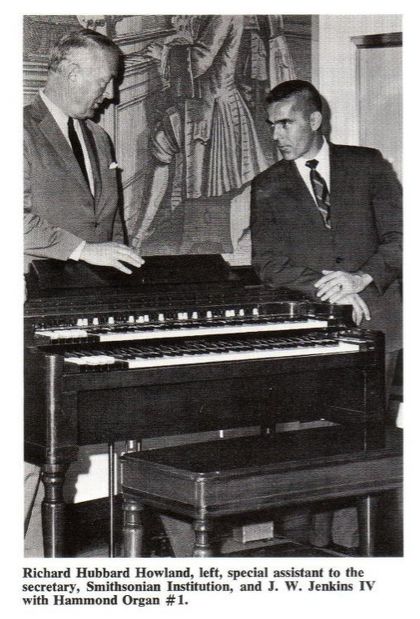De Hammond Encyclopedie
- De eerste Hammond: Model A
- Serienr. 1 in Smithsonian museum
- A-K series
- L-X series
- Overige Bijzondere Modellen
- Modellen Wegwijzer
- Modelleninformatie Bluebook
- Referentie Typenummer / Modelnaam (1)
- Referentie Typenummer / Modelnaam (2)
- Het originele patent
- Hammond OEM toepassing
- Reverb history
- Hammond MIDI
- Hammond Rhythm boxen
- Hammond Tooncabinetten
- Hammond folder museum
- Orgel Uitbreidingen
Serienr. 1 in het Smithsonian museum
Hieronder de beschrijving van Hammond A, serienummer # 1, die zich nu in het Smithsonian bevind. (Let wel, Laurens Hammond maakte hiervóór natuurlijk al prototypes,
o.a. voor het verkrijgen van de patenten, etc.)
A few months ago, I mentioned the first Hammond being in the Smithsonian. I've reproduced the following article from the Dec '68/Jan '69 issue of The Hammond Times:
"Smithsonian Institution Adds First Hammond Organ to Collection"
The first hammond Organ, manufactured 34 years ago, has taken its distinguished place among other historical musical instruments at the Smithsonian Instituition, Washington, D.C.
The organ was presented to the Instutution by Hammond president, David H. Kutner, and J.W. Jenkins IV, president, Jenkins Music Company, Kansas City, Mo. Accepting Hammond Organ serial # 1 was John Fesperman, associated curator of the Institution's division of musical instruments.
"It is with a great deal of pride that we present this first Hammond Organ to the Smithsonian," said Kutner. "Our company is very proud of the part the electric organ has played in the historic evolution of music in this country and throughtout the world."
In accepting the organ, Fesperman announced that it will go into the Institution's reference collection of musical instruments and also will be used in future exhibits of the division.
Kansas City Church - Original Owner
Original owner of this first Hammond was the Paseo Methodist Church in Kansas City, Mo., which bought it in 1935. Shortly after laurens Hammond had his electric organ patented in 1934, Hammond salesmen took the instrument around the country for demonstrations and to stimulate sales. One of the first stops was Kansas City, Mo.
"My father, Paul Jenkins and his cousin J.W. Jenkins who owned Jenkins Music Company had been talking to the members of the Paseo Methodist Church about buying an electric organ just about the time the Hammond people came to town to demonstrate their new product. They were very impressed with the instrument and took the representatives from the church to see it," said Jenkins. "They too liked the organ but said they would only buy one if they could have the instrument that was being demonstrated and that's how they got Hammond serial #1."
The Hammond Organ Company at that time had no dealers and as a result of the sale of the organ to the church, Jenkins Music Company became Hammond's first franchised dealer in the United States. The church continued to use the organ from 1935 until early 1950 when it was traded in for a newer model. About a dozen years after the organ was purchased, Rev. Edward W. Potts wrote the company that upkeep on the organ had amounted only to a new set of tubes for the amplifier...but he added that he might soon need to order another can of oil.
Jenkins Music Company continued to use the organ for special merchandising displays and promotions throught the years. Hammond's first consumer advertisement appeared in the April 25, 1935 issue of Musical America magazine. While the first ad stressed the instrument's appeal to the professional musician, the electric organ today has gained wid popularity for homes, churches, schools, clubs or virtually any place where ther is a need to make musical sounds.
There was also a photograph showing a young crew-cut gentleman (Jenkins) and an older gentleman (Howland) leaning on the organ with caption "Richard Hubbard Howland, left, special assistant to the secretary, Smithsonian Institution, and J.W. Jenkins IV with Hammond Organ #1."
So it appears the organ may be stashed away in their "reference collection" and not necessarily on display. I think the Smithsonian has a web site. We should all insist that they get the organ out of the backroom and put it on display. I suspect there would be a mass pilgrimage of list members to Washington, D.C.
Steve in Berkeley
